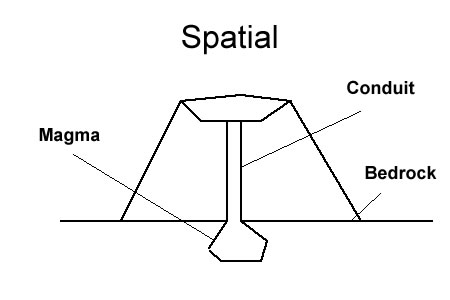Spatial organization is when information in a passage is organized in order of space or location. If you were to describe the room in which you were sitting right now, you would be using spatial organization. Spatial organization may also be called descriptive writing and it is most frequently used when the narrator describes how something looks. Spatial organization is generally pretty easy to identify, but be aware that spatial organization is used in both fiction and nonfiction texts. Most fictional passages are organized chronologically, but in paragraphs where the narrator is describing a setting or the appearance of a character, the information may be organized spatially.
Example: Volcanoes are a feared and destructive force for good reason. A volcano is like a pressure valve for the inner earth, but they can also be very beautiful. One part of the volcano that people rarely see is the magma chamber. The magma chamber is way beneath the Earth’s bed rock. It is tremendously hot. Running from the magma chamber to the crater of the volcano is the conduit. The conduit connects the magma chamber to the outer world. At the top of the volcano is the the crater. This is where the magma exits. Volcanoes are a beautiful yet dangerous natural phenomenon.
There are many different graphic organizers you can use to represent the information in a spatially ordered passage. You could draw whatever information is described in the passage.
Some signal words that might indicate that the writer or speaker is following the spatial pattern of organization include a wide sweeping array of prepositions, some of which I will now list: next to, behind, across from, below that, above that, to the right of and so forth.
Here is a simple spatial order worksheet if your students need more practice.
Here is a more complex series of worksheets on text structure for more advanced students.
Learn More About Patterns of Organization
Patterns of Organization
Text Structure Worksheets and Activities
Interactive Text Structure Practice Quiz
All Reading Worksheets


Garinger S Togba
/ October 12, 2020love it
DJ-xXGoldSolaceXx
/ February 6, 2020Thanks!
B.Mickey
/ October 22, 2019Your site is AMAZING! Thank you for all of your had work in helping so many.
In the Power Point ( Text Structure) the question # 7: Three Types of Clowns: the word Auguste is not spelled correctly. It reads august.
I am an auguste clown!
Tyavyar Terhide (a.k.a. OG)
/ July 4, 2016Nice website, it’s interesting. Thanks.
tasha
/ March 22, 2016i really love this site it helped me alot
lusajo simon
/ December 25, 2015thanks alot for spatial explanation
Pauline4569
/ December 2, 2015Thanks for your help! i really get it now
Brandi
/ January 14, 2015This website helps a lot. I missed a lot of school and this helped me catch up. Thanks.
adilahhusna
/ December 11, 2014this is actually i want. i search it for my whole semester. now it just 2 weeks left and i found this. thank you very much sir
carebi
/ November 6, 2014good website
koami
/ August 19, 2014can we use chronological and spatial organization for 1 story?
Mr. Morton
/ August 19, 2014Yes. One paragraph could describe the setting and the other paragraphs could move the action forward in time.
Mickcole
/ April 15, 2014very good
jimmychew
/ January 12, 2014awesome
dhruv
/ March 12, 2013we need this for our project u did a good job thank u dhruv
Belinda
/ March 11, 2013Love the easy to navigate site and the wealth of information!
Mr. Morton
/ March 13, 2013That’s kind of you to say. Thank you for visiting!
reshma
/ March 7, 2013excellent website,i am a teacher and benefitted a lot from this
christian
/ January 3, 2013thank you
lydid
/ December 14, 2012not very helpful…. i would use this site again except all the signal words are not there.
Dan Paul
/ December 13, 2012This is informative
otaga godfrey
/ September 27, 2012nice
chritains
/ September 20, 2012this is the website that i need